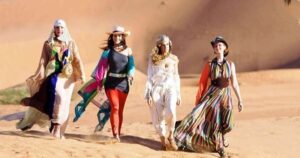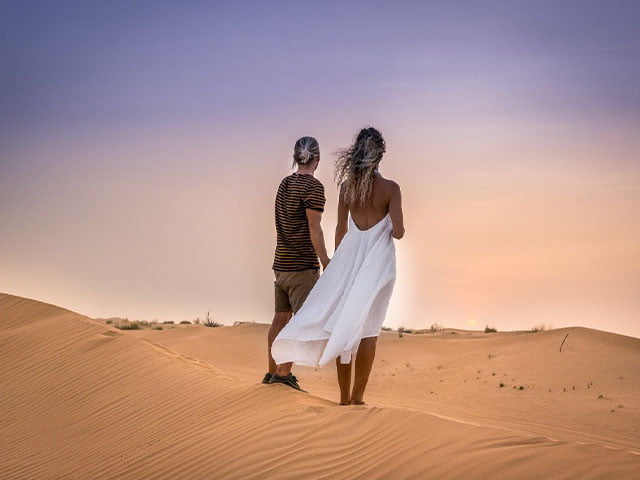what to wear in desert safari? Jumping on a desert safari Dubai is an exciting venture that allows you to indulge in theses attractive charm of beautiful landscapes. It offers you a distinct mixture of hopefulness and calmness. When you prepare yourself for this fantastic trip it is critical to stick to a reasonable dress code that not only makes you comfortable and safe but also respects the local culture and atmosphere. In this comprehensive guidebook, we shall introduce you to the important elements of dressing for a desert safari. It ensures that you are prepared for a remarkable journey.
Understanding the desert environment:
Before delving into the specific dress code, it is necessary to understand the nature of the desert areas. Deserts have scorching daytime temperatures and conditions. So the dress code you select must be protected from severe sunrays, ventilation, and adaptability to changing temperatures.
Lightweight and Breathable clothing:
While choosing your dress code for your desert safari Dubai, opt for a lightweight and breathable fabric that aids in regulating your body temperature and wicks away your humidity. Cotton and linen stuff are the best selection because they let air circulate and avoid overheating. Loose-fitting, long-sleeved pants, and shirts give safety against the harsh sun rays and avoid the dangerous climate.

Neutral and Light Colors:
The severe sunlight of the Desert can be unforgiving, making it necessary to wear dresses in neutral and light colors. These colors reflect the sunlight instead of absorbing them. These will help you to feel cooler throughout your safari trip. Light brown, khaki, Beigi, and pale grey shades are perfect color options that mix seamlessly with the desert atmosphere. These light colors will make you feel easy and relaxed.
Thin gloves:
If you have planned to engage in activities like sandboarding or camel riding, consider wearing thin gloves to protect your hands against the hot desert sand.
Belt or Scarf:
A lightweight belt or scarf can help you to secure yourself against strong desert wind.
Sun protection:
Protecting yourself from the desert is very important. Select a wide-brimmed hat to save your face, ears, and neck from direct sunlight. Use sunglasses with UV protection, they will protect your eyes from the brightness and give you comfort. Must remember to apply a high-SPF sunscreen to all uncovered areas of your skin. Consider a lip balm with sunblock to save dry lips.
Closed-toe shoes:
As sandals may be seductive in hot climates, comfortable, sturdy closed-toe shoes are the best selection for a desert safari against rocky areas. Strong, hiking shoes or soft sneakers with good grip will save your feet from rough land, thorny plantations, and hot sandy areas. It is also a good suggestion to wear humidity-wicking socks.
Head scarf or Shemagh:
In some desert areas, putting on a head scarf or shemagh (a traditional Middle Eastern headwear) is not merely practical but also must be respectful culturally. These headwear give extra protection for your head and neck against the sunlight and hot sand. These items can also cover your face in the severe windy season.
Layering Options:
Desert temperatures can be different between daytime and nighttime. Keep a lightweight jacket or a long-sleeved shirt that you can easily wear when the temperature decreases. Layering lets you adapt to varying conditions, ensuring your leisure throughout the year.
Minimum jewelry:
While dressing for a desert safari, it is suggested to keep a minimum of jewelry with you as large shiny jewelry can reflect sunlight and can draw unnecessary attention. Instead, use a simple artificial one for your safety and comfort. So it is the best option for you to wear minimum and simple jewelry items as safety must be in your priorities.
Respect for Local Culture:
Before starting your desert safari, spend some time researching to know about the cultural traditions and norms of the region you intend to visit. Some desert areas have conservative dress codes while visiting some cultural places or communicating with local communities. Always be peaceful and respectful of local traditional customs. Never go against the customs and traditions of any visiting area.
Lightweight Backpack:
Always travel light and carry a lightweight backpack with some necessities of life like water, biscuits, snacks, a camera, and a map without stopping your movements. Use a backpack with adjustable straps for comfort and ventilation, avoiding excessive sweating on your body, especially your back.
Emergency supplies:
Always remember to carry emergency supplies like a basic first aid box, a flashlight, and a whistle. Although these items may not directly relate to your dress code or attire, they are necessary for your overall protection during the desert adventurous activities. These items can be very helpful in case of any emergency for your safety and protection.
Conclusion:
As desert safari offers you a variety of opportunities to connect with nature’s raw beauty, tour dress plays a very important role in your safety and comfort. What to wear in Desert Safari and choosing a suitable dress code opportunity for a desert safari is a combination of feasibility, comfort, and cultural sensitivity.
By sticking to a particular dress code that keeps lightweight and breathable clothing, sunrays protection, closed-toe shoes, wearing cotton, and respecting local customs and traditions in your priorities, you will be ready to fully enjoy the beauty and majesty of the Deseret. So it is suggested to start your adventure with the right dress code and attire. You are bound to produce lasting memories of your desert safari experience. Don’t forget that safety, comfort, and adaptability are the key rules when choosing your desert safari attire.

